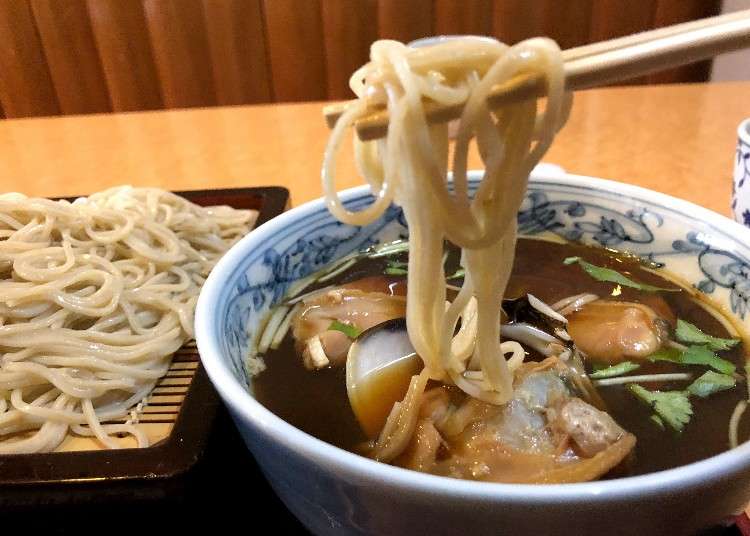
Soba is a noodle dish in which the noodles are made with the flour of the ground seeds of buckwheat, an annual plant. Since ancient times in Japan buckwheat flour was kneaded and eaten uncut, but after time the custom of slicing the dough into thin noodles came about.
Eventually they took the forms as we know them today. It is also considered to be an auspicious food, and in Japan the custom of eating it at certain junctures in life, such as when moving or at the end of the year, is well-known. Soba is imbued with symbolic meanings. Compared to other noodles, it is easy to cut and as such it symbolizes the "severing" of misfortune while the long, thin noodles symbolize longevity.
So it's fitting to enjoy such a delicious, auspicious dish in Tokyo's historical district of Asakusa!
Why was soba so highly prized in Asakusa, the home territory of the Edo Shogunate?
Above all, the soba culture developed greatly during the Edo period of Japan (1603-1868). Soba that was eaten on the streets of Edo by busy merchants hungry for a quick, filling meal was called “Edo Soba”. The soba that was made from buckwheat seeds gathered between summer and autumn was called “new soba” and was highly prized among Edo merchants.
To this day there are still many soba restaurants in Tokyo’s Asakusa district attesting to this rich vestige of Edo culture. Not only are there long-established shops reminding us of that Edo culture, but there are also many shops offering soba in ways uniquely adapted newer times. Join as we introduce three stellar shops!
1. Shiba Ebi: Exquisite tempura soba
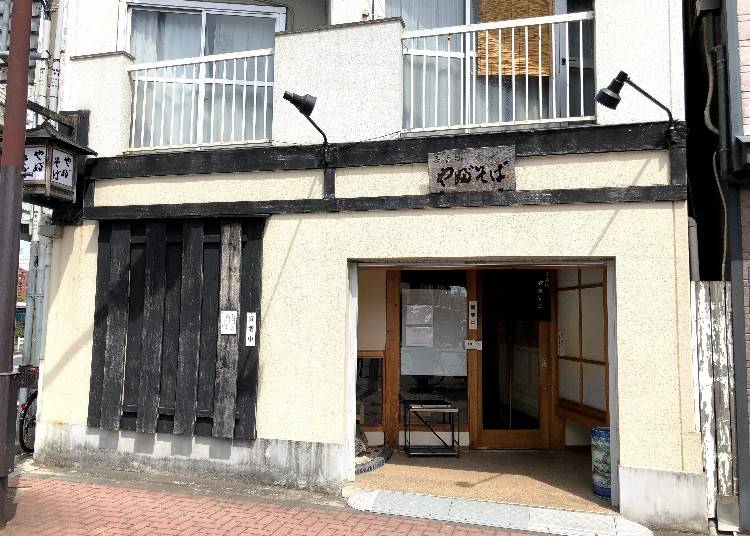
There are three branches of Japanese soba extending from the Edo period. The "three major branches" are called Yabu Soba, Sarashina Soba, and Sunaba Soba, and the Azumabashi Yabu Soba, as its name implies, traces its roots back to Yabu Soba. The shopkeepers are trained at Kanda Yabu Soba, a famous Japanese soba restaurant established in 1880.
The shop named Azumabashi takes its name from the location where it began business near the Azuma Bridge that spans the Sumida River. It has since been relocated and is currently located near the Komagata Bridge that spans the Sumida River.
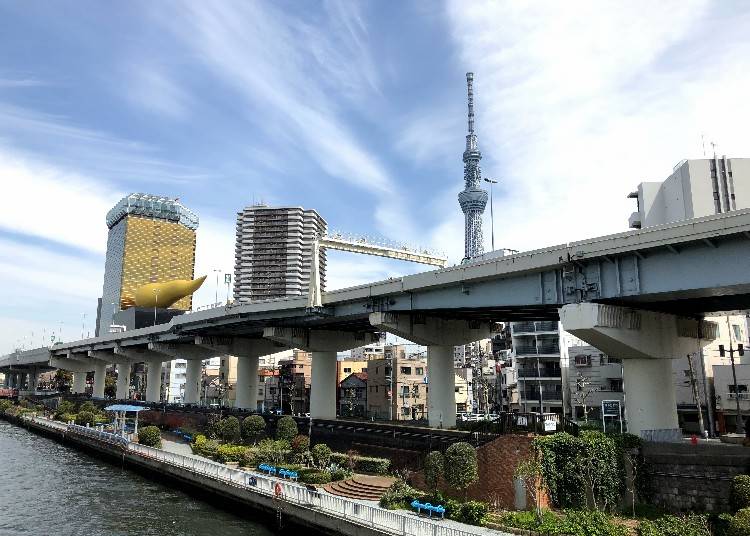
![Caption: Shiba Ebi Kakiage [mixed vegetable and seafood tempura] Tempura Soba (1,700 yen including tax) has mitsuba [Japanese honewort] in it.](https://rimage.gnst.jp/livejapan.com/public/article/detail/a/00/02/a0002058/img/en/a0002058_parts_5d088e1b524b7.jpg?20190618162837&q=80)
We tried the Tempura Soba with the kakiage. Normally it is served in hot soup, but it is also possible to order a chilled version. The kakiage is kept simple with just Shiba shrimp and the deep-fried batter exterior is light and crisp. When the kakiage, hot out of the fryer, is placed on the dish it makes a sizzling sound as it absorbs the soup. The name Shiba Ebi is named after the shrimp that in Edo times was caught in Shibaura, the name of the inlet near Shiba, and which is known for being a main ingredient in Edo-style tempura. Shiba shrimp are small and plump so when several are dipped in batter and fried together when making kakiage.
Soba is made by the shopkeeper every morning in a room for that purpose in the shop. The soba has an excellent and pleasant texture. The fried kakiage is not at all greasy and goes deliciously well with the slightly sweet soy sauce based tsuyu. It is also accented with a bit of yuzu shavings on top.
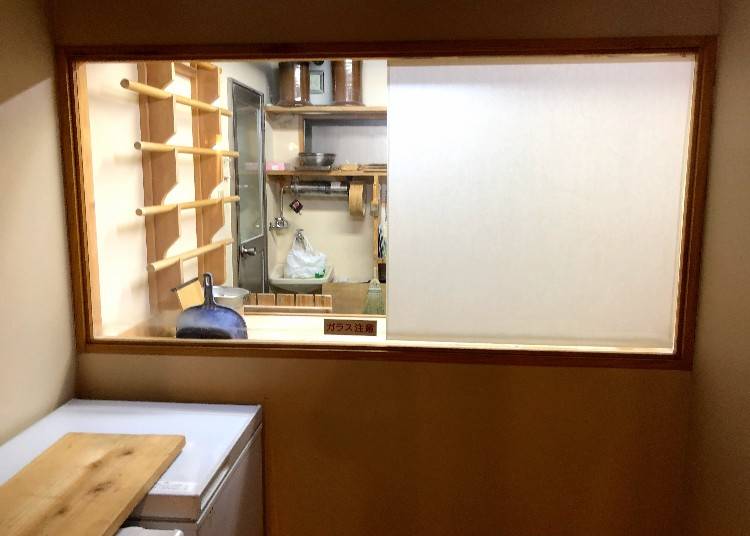
This shop is noted for its rich menu offering 15 different types of soba. It is especially noted for its dishes that contain sticky ingredients, which many foreign visitors often find difficult to eat, such as cold Natto Soba (1,100 yen), Nameko Soba (2,200 yen), and Yamakake [grated Japanese yam] Soba in addition to hot soba dishes. The shop also has a wide selection of snacks that go well with sake, which is also available from noon.
-
AZUMABASHI YABUSOBA吾妻橋やぶそば
- Address 1-11-2, Azumabashi, Sumida Ku, Tokyo 130-0001
-
Nearest Station
About a 5-minute walk in the Toei Shinjuku Line Asakusa Station exit going towards Komagata Bashi Bridge
- Phone Number 03-3625-1550
Open: 11:00 a.m. ~ 3:00 p.m. (Shop closes when sold out)
Closed: Mondays and Tuesdays
2. Benten: Enjoy soba in a long-established restaurant that retains the atmosphere of the Asakusa Geisha quarter
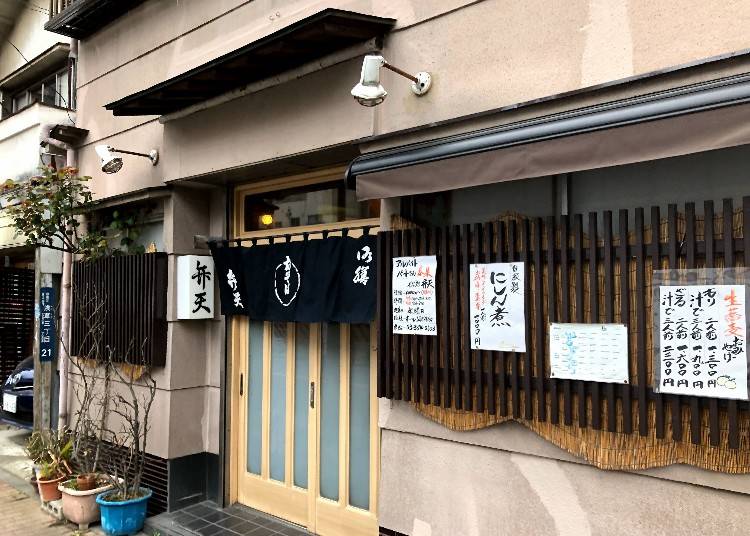
Benten, its shop located in a back street of Asakusa, was established in 1950. This area is called "Asakusa Hanamachi [Flower Town]", a euphemism for the red-light district, and it has prospered as an entertainment district where "Geisha houses" and restaurants have lined the streets since the middle of the Edo period. A Geisha house is an establishment that dispatches "Geisha" who dance and play musical instruments at drinking parties. One such establishment, Asakusa Kenban, across the street, still continues to dispatch Geisha.
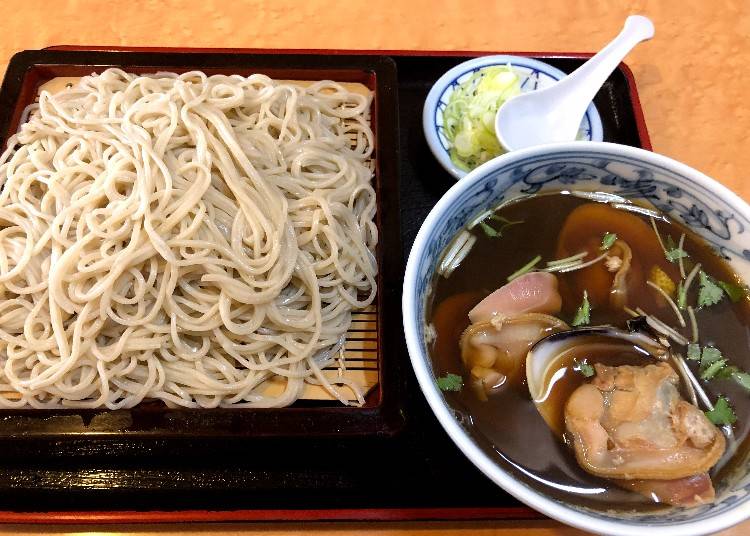
Benten has a seasonal menus offering a wide selection for each season. This is a tradition that has been handed down through generations. Among them, the Hamaguri Seiro, a spring specialty containing large, plump clams served tsukesoba-style in a hot broth, is famous here. This had been a dish only offered in spring during the long clam season, however, because it is so popular it is now served year-round. By the way, other dishes limited to the seasons are Matsutake Soba, using domestic matsutake mushrooms in autumn and Kaki Nanban Soba, containing oysters, in winter.

The Hamaguri Seiro contains four large clams. The clams are a product of Chiba. They are easy to eat because the meat has already been removed from the shell. The broth from the clams perfectly fits the tsuyu [noodle soup base] giving the noodles dipped in it a clam flavor. Soba noodles that mix well with the tsuyu are made with 3 parts wheat flour and 7 parts buckwheat flour. The shop uses domestic buckwheat flour. Incidentally, the dried bonito shavings used for the tsuyu are freshly made at the shop.
Another major feature here is that the tsuyu used for mori soba and zaru soba are different. Both are chilled soba served on bamboo-latticed trays. Many soba shops in Japan serve both chilled types of soba without the same ingredients. Although there are various theories, in most soba shops, usually zaru is topped with nori, whereas that without any topping is called mori. The tsuyu for mori has a straight bonito flavor, and at Benten, kaeshi, which is a blend of soy sauce, mirin [sweet sake], and sugar, is added to the mori tsuyu to make the zaru tsuyu which has a bolder flavor. You might enjoy comparing the difference.

-
Benten弁天
- Address 3-21-8, Asakusa, Taito Ku, Tokyo To, 111-0032
-
Nearest Station
8-minute walk from the Asakusa Station on the Tsukuba Express Line
- Phone Number 03-3874-4082
Hours: 11:30 a.m. ~ 20:00 p.m. (L.O. 9:30 p.m.), Sundays 11:30 a.m. ~ 9:30 p.m. (L.O. 8:00 p.m.)
Closed: Wednesdays
3. Ozawa: Thick soba noodles with good, firm texture
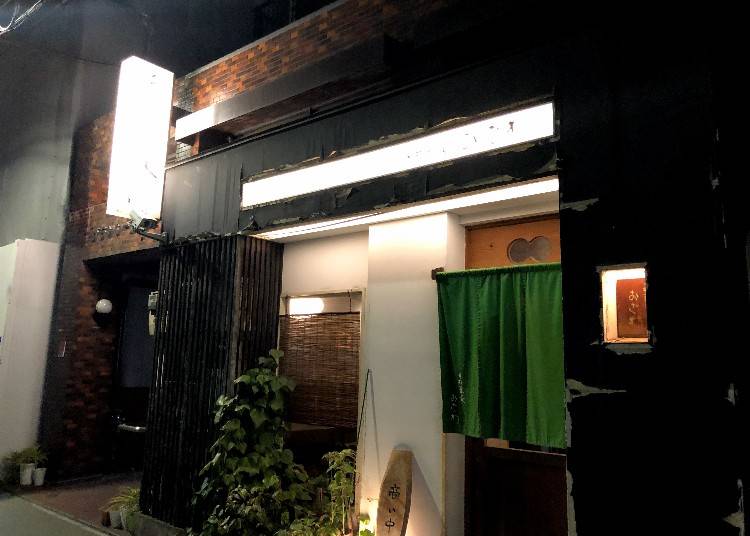
Ozawa is the third shop offering handmade soba noodles on our list. Established in 1999 in Inaricho near Asakusa, it moved to its current location on the road behind Kokusai-dori in Asakusa. This shop is famous for its Futouchi Zaru, which probably surprises Japanese accustomed to normal-sized noodles more than it does foreigners. These noodles are many times thicker than standard-sized noodles and are chewier.

Ozawa also offers two other types of soba, too: hosogiri [thinly-sliced] and arabiki [coarse-ground]. The difference is not only in the size of the noodles, but the buckwheat flour used for each comes from a different locality. The locality where it was produced varies depending on the day, but on the day we visited, notices on the wall indicated that the buckwheat flour for the hosogiri was produced in Numata, Hokkaido, that for the arabiki in Kita Ibaraki, and that for the futouchi in Shiwa, Iwate. Furthermore, the composition is different; that for the hosogiri uses 1 part wheat flour to 9 parts buckwheat flour, making a smoother noodle, while the arabiki is made entirely with buckwheat flour.
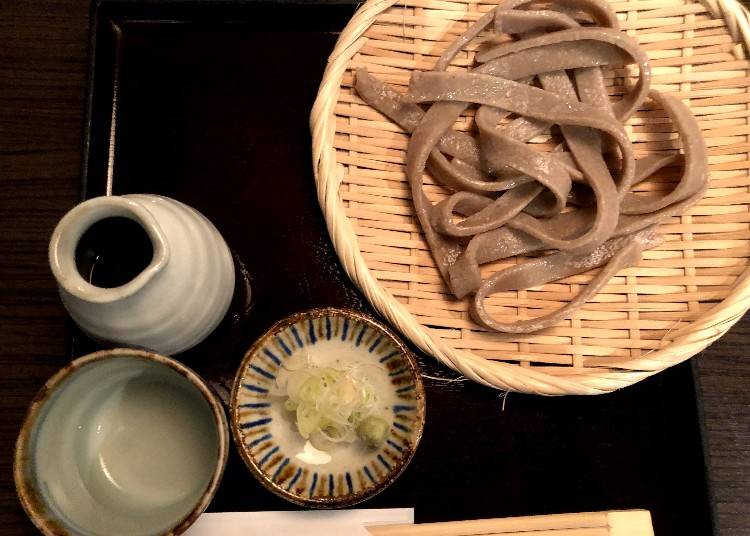
So how did these thick soba noodles come about? According to the shopkeeper, when the shop was located in Inaricho, there was a regular customer who preferred thick noodles and always requested “fatter” noodles. It was in compliance with his request that this size was created. Both the flavor and the sound of slurping the noodles are essential to the way soba is normally eaten and natural to Japanese. These thick noodles have a springy texture and are chewed one at a time. Eating them in this way delivers the full flavor of the buckwheat and gives the satisfying sensation of “eating soba”. It may not look like a large portion, but it is equivalent to an extra-large portion of normal soba.
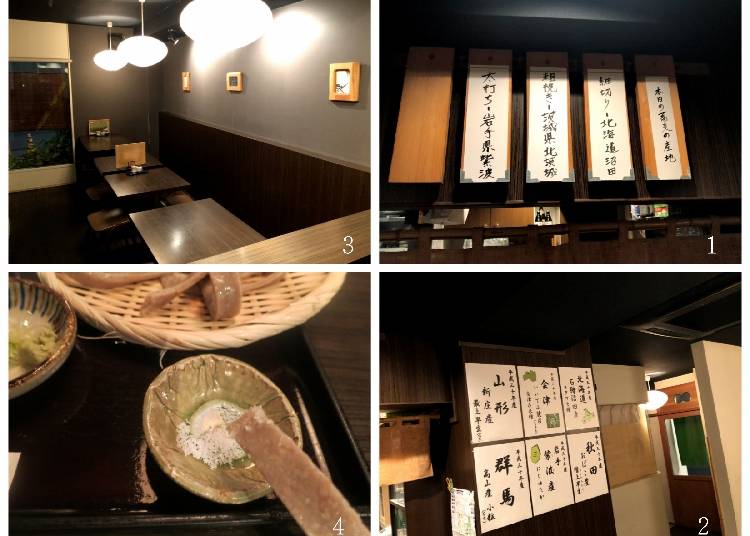
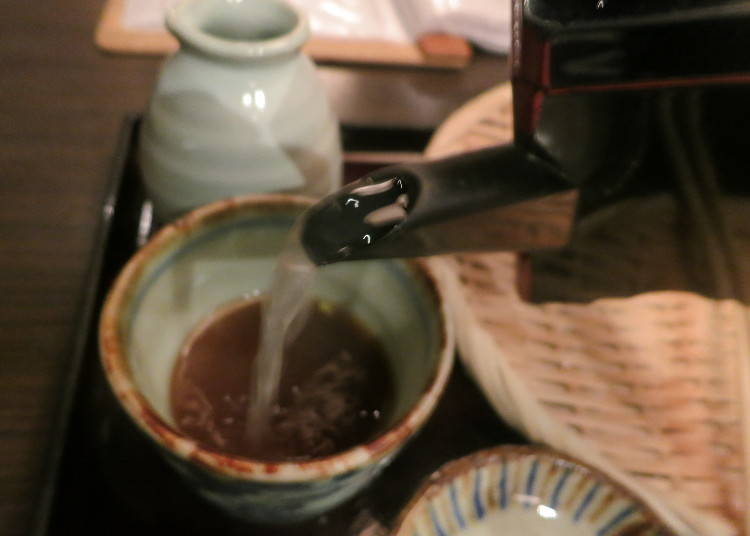
One more thing: the tsuyu that comes with chilled soba is too salty to drink straight. So normally sobayu [hot water in which the soba was boiled] is added to it. This is something you should definitely try after you have eaten the soba. Almost all soba shops in Japan proffer sobayu after you have eaten the noodles. This is provided at no extra charge as a service, so be sure to try it.
-
OZAWAおざわ
- Address 2-25-15, Nishiasakusa, Taito Ku, Tokyo To, 111-0035
-
Nearest Station
2-minute walk from the Asakusa Station on the Tsukuba Express Line
- Phone Number 03-3841-6450
Hours: 11:30 a.m. ~ 2:30 p.m., 5:30 p.m. ~ 8:30 p.m.
Closed: Mondays and Tuesdays
- Area
- Category
*Prices and options mentioned are subject to change.
*Unless stated otherwise, all prices include tax.
Popular Tours & Activitiess
Recommended places for you
-

How to Get Don Quijote's Exclusive 2025-2026 Winter Gift (+Tax-Free Savings)
-

New in Ginza! Air BicCamera Ginza Opens with a Faster, More Convenient Shopping Experience
by: Guest Contributor
-

Strawberries, Style, and Tokyo’s Coolest Neighborhood: Winter Afternoon Tea in Kichijoji
by: Guest Contributor
-

Japan’s Shinkansen Is About to Change Travel in an Unexpected Way
by: Guest Contributor
-
Ad

Complete Guide to Ueno's National Museum of Nature and Science, the Perfect Place to Visit on Rainy Days or With Children
-

First Japan Cherry Blossom 2026 Forecast Announced! Here's When & Where to See Sakura in Japan
Inspiration for Accommodations
-

Enjoy Mt. Fuji from the Comfort of Your Room! Recommended Ryokan with Mt. Fuji View
-

Stay Near the Cherry Blossoms! Hotels for Cherry Blossom Viewing in Tokyo
-

Family-Friendly Hotels with Free Shuttle to Disneyland: Convenient Access for a Magical Stay
-

Top Ranked Hakone Hotels with Mt. Fuji View: Enjoy Stunning Scenery from Your Private Space
-

Convenient Tokyo Hotels with Airport Shuttle: Ideal for Families and Heavy Luggage
-

Stunning Tokyo Tower View Hotels: Enjoy Spectacular Scenery from Your Private Space
-

Convenient Asakusa Hotels with Kitchens: Ideal for Extended Family Visits
-

Experience Luxury: Hakone's 10 Best Five-Star Accommodations
-

Enjoy Mt. Fuji Autumn Leaves! Top Hotels Near the Popular Autumn Leaves Corridor
-

Experience Hakone Fall Foliage from Your Room with Stunning Views
-

Tokyo Tsukiji|Tsukiji Area Map & Sightseeing Information
-

Healthcare in Japan for Tourists: What to Do When You Get Sick or Injured in Japan
-

Complete Guide to Buying Japanese Medicine in Japan: Phrases and Vocabulary You Need to Know
-

Udon and Soba
-

Lunch in Shinjuku: 5 Best Restaurants Under $12 - Enjoy Wagyu, Sushi, and Tempura for Cheap!
-

Check Out These Top 3 Delectable Dishes at Tokyo's Incredibly Popular 24-Hour Fuji Soba Shop!
- #best ramen tokyo
- #what to buy in ameyoko
- #what to bring to japan
- #new years in tokyo
- #best izakaya shinjuku
- #things to do tokyo
- #japanese nail trends
- #what to do in odaiba
- #onsen tattoo friendly tokyo
- #daiso
- #best sushi ginza
- #japanese convenience store snacks
- #best yakiniku shibuya
- #japanese fashion culture
- #best japanese soft drinks


















